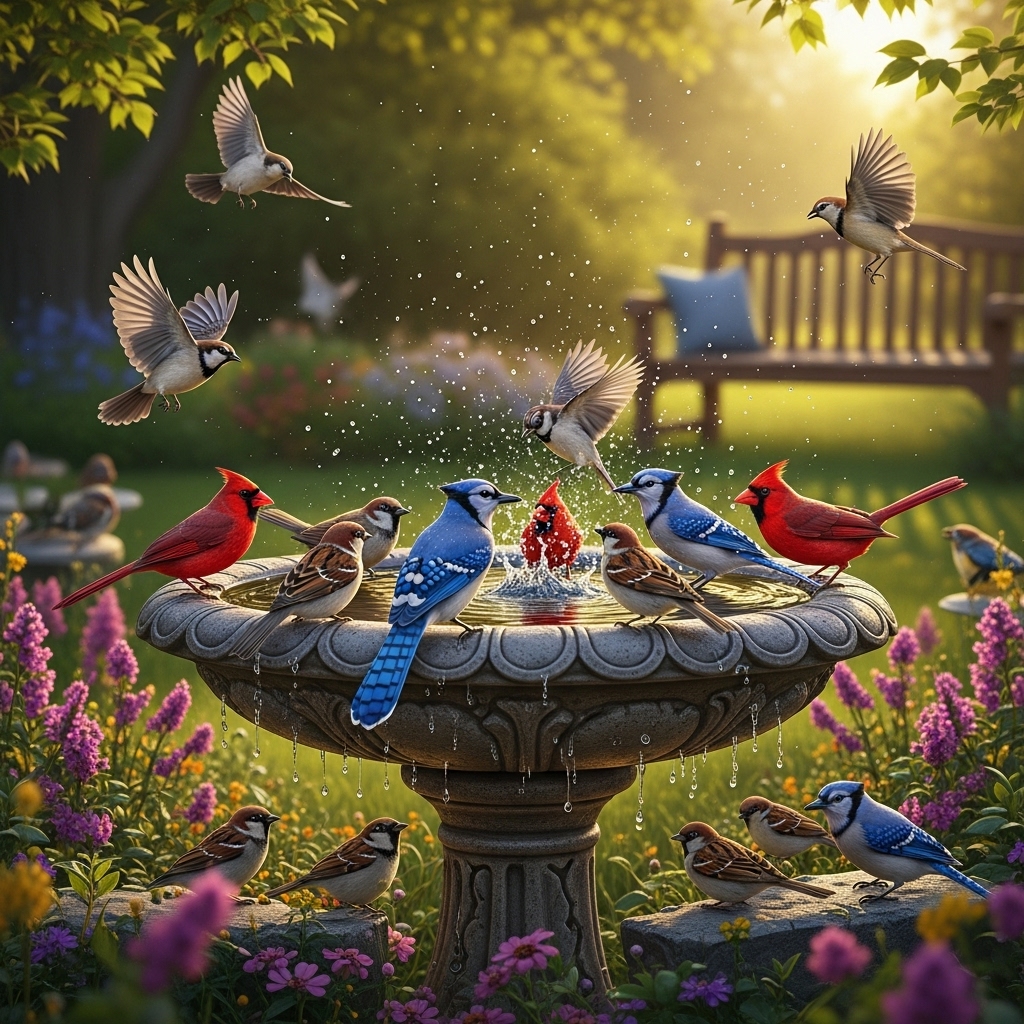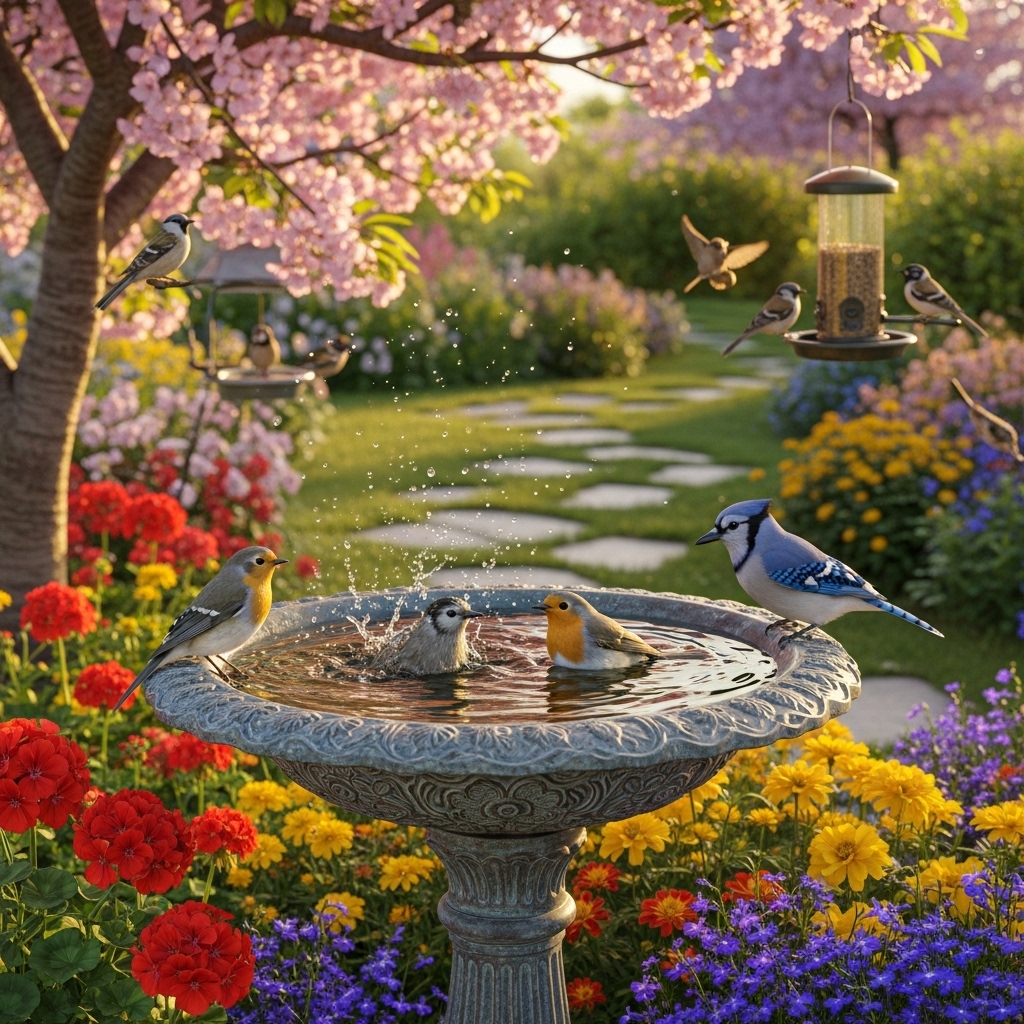Creating a haven for birds in my backyard has been one of the most rewarding experiences. Among the many ways to attract these beautiful creatures, a well-placed birdbath can make all the difference.
Understanding the Importance of Birdbaths

When I first considered adding a birdbath to my garden, I didn’t realize just how essential it could be for the local bird population. Birdbaths serve as a vital source of water for birds, especially in areas where natural water sources are scarce. Not only do they provide a space for birds to drink, but they also offer a place for them to bathe and keep their feathers in pristine condition. I’ve come to appreciate that a clean and well-maintained birdbath can attract a diverse array of species, creating a lively and vibrant atmosphere in my yard.
The Benefits of Having a Birdbath
As I delved deeper into the world of birdwatching, I discovered several benefits that came with having a birdbath. For starters, it draws in a variety of birds that might not otherwise visit my garden. I’ve seen everything from elegant robins to colorful finches flitting about, and their presence has brought so much joy to my outdoor space.
Additionally, I learned that birdbaths can help support bird health. Birds use baths not only for hydration but also for grooming. Keeping their feathers clean is essential for insulation and waterproofing, which ultimately affects their survival. Watching them splash around has become a favorite pastime of mine, as I observe their unique behaviors and interactions.
Choosing the Right Birdbath
When it came time to choose a birdbath for my yard, I found that there are several factors to consider. The style, material, and size of the birdbath can significantly influence its functionality and appeal to birds. I began by researching different types of birdbaths to identify what would work best for my space.
Material Matters
The material of the birdbath is crucial, as it impacts both durability and maintenance. I learned that ceramic, metal, stone, and plastic are common materials used for birdbaths, each with its pros and cons. Ceramic birdbaths are often aesthetically pleasing and can come in beautiful designs, but they can be heavy and may crack in extreme temperatures. Metal options are durable but can heat up in the sun, potentially making the water uncomfortable for birds. Stone birdbaths offer natural beauty and stability, while plastic is lightweight and easy to move, although it may not be as visually appealing.
Size and Depth Considerations
As I started to narrow down my choices, I realized that size and depth also play a critical role in attracting birds. I wanted a birdbath that was shallow enough for smaller birds to feel safe while splashing around. Ideally, I aimed for a depth of no more than 2-3 inches. A wide, flat surface is also beneficial, allowing multiple birds to bathe at once, which has led to some delightful scenes in my garden.
Style and Design
In addition to functionality, I wanted my birdbath to complement the overall aesthetics of my garden. I found that there are numerous styles available, from traditional pedestal designs to modern hanging options. I opted for a classic pedestal birdbath that provides a stable base and is elevated above the ground, making it easier for birds to spot. I also appreciated that many designs come in various colors and patterns, allowing me to select one that matched my garden’s theme.
Placement of the Birdbath
After selecting the perfect birdbath, the next step was deciding where to place it. I realized that the location is just as important as the birdbath itself. Birds tend to feel more secure when they have a clear view of their surroundings. I chose a spot in my garden that was slightly elevated and offered some nearby bushes and trees for cover. This way, the birds could easily escape if they sensed danger.
Sunlight and Shade Balance
Another consideration was the balance of sunlight and shade. I learned that placing the birdbath in a sunny spot helps keep the water from freezing in winter and discourages algae growth in warmer months. However, I also wanted to ensure that some shade was available during the hottest parts of the day. A little experimentation with placement allowed me to find the perfect spot that kept the water refreshing while also providing birds with a comfortable bathing experience.
Accessibility for Birds
As I positioned the birdbath, I made sure it was easily accessible for birds while remaining away from potential predators, such as cats. Keeping it at least 10 feet away from cover helped minimize any risks. I also placed some stones or pebbles at the bottom to create a gradual slope, allowing smaller birds to wade in safely. With these considerations in mind, I felt confident that I was providing a safe and welcoming environment for my feathered friends.
Creating a haven for birds with a well-chosen and strategically placed birdbath has transformed my garden into a lively sanctuary. Each day brings new visitors and delightful experiences, and I can’t wait to share more insights on how to maintain and enhance this beautiful addition to my backyard in the next section.
Maintaining Your Birdbath

Once I had set up my birdbath, I quickly realized that maintaining it is just as important as choosing the right one. A clean and well-maintained birdbath not only looks better but also plays a vital role in the health and safety of the birds that visit. Over time, I’ve developed a routine that keeps my birdbath in top condition while ensuring that it remains an inviting spot for my feathered guests.
Regular Cleaning
One of the first things I learned was the importance of regular cleaning. I make it a point to change the water in my birdbath every few days, especially during hot weather when evaporation occurs more rapidly. This helps to ensure the water remains fresh and enticing for the birds. I also discovered that cleaning the basin thoroughly is essential to prevent the growth of algae and harmful bacteria.
For cleaning, I use a mixture of water and white vinegar or baking soda, which are both effective and non-toxic options. I scrub the surface gently with a soft brush or sponge, being careful not to scratch the material of the birdbath. After rinsing it well, I refill it with fresh water. This simple routine has made a noticeable difference in attracting birds to my garden, as they seem to prefer crystal clear water.
Seasonal Considerations
As the seasons change, so do the needs of my birdbath. In the warmer months, I find that algae can grow more rapidly, necessitating more frequent cleanings. I keep an eye on the water quality and adjust my cleaning schedule accordingly. Additionally, I often check the water level, as hot weather can lead to faster evaporation.
As autumn approaches, I prepare for the cooler months by considering how to prevent my birdbath from freezing. I have invested in a birdbath heater, which is a simple device that keeps the water from freezing solid. This not only benefits the birds in winter but also allows me to enjoy watching them throughout the colder months. I make sure to place the heater according to the manufacturer’s instructions and regularly check that it’s working properly.
Enhancing the Experience
To further enhance the experience for the birds, I’ve also experimented with adding stones and pebbles to the bottom of the birdbath. This not only provides a safe place for smaller birds to perch but also creates a more natural look. I’ve found that birds, especially the smaller species, feel more secure when they have something to stand on while they drink or bathe.
Another fun addition has been placing some floating birdbath accessories, like small rubber ducks or flower-shaped floats. These not only add a bit of charm and personality to my birdbath but also encourage birds to interact with the water. I’ve noticed that birds seem more curious and playful with these little additions, making my backyard even more entertaining.
Creating a Bird-Friendly Environment
While the birdbath is a significant attraction, I’ve learned that creating a bird-friendly environment overall is key to drawing in a variety of species. I’ve added native plants and shrubs to my garden, which provide natural food sources and shelter for birds. Sunflowers, coneflowers, and berry-producing plants have become favorites among the local birds, offering seeds and fruits at different times of the year.
I also try to minimize pesticide use in my garden. Instead, I rely on natural pest control methods or organic treatments to ensure that the birds have a safe environment. By fostering biodiversity with a variety of plants and minimizing harmful chemicals, my garden has become a haven not only for birds but also for butterflies and other beneficial insects.
Engaging with Birdwatching
Another rewarding aspect of maintaining my birdbath is the opportunity it provides for birdwatching. I’ve set up a comfortable chair nearby, allowing me to relax while observing the different species that visit. Keeping a journal of the birds I see has been a delightful project, helping me appreciate the diversity of life that shares my space. I’ve even taken up bird photography, capturing the beauty of these fleeting moments.
As I sit in my garden, I often feel a deep connection with nature. Each splash of water, every chirp, and flutter of wings reminds me of the importance of providing a safe and welcoming space for wildlife. I’ve found that through my efforts in maintaining the birdbath and creating a bird-friendly environment, I’m not just nurturing the birds; I’m also enriching my own life with joy and wonder.
Final Thoughts
Creating a haven for birds with a well-maintained birdbath has transformed my garden into a lively sanctuary. Each day brings new visitors and delightful experiences, and I can’t wait to share more insights on how to maintain and enhance this beautiful addition to my backyard in the next section.
By embracing the responsibilities of caring for my birdbath and nurturing my garden, I’ve not only attracted countless bird species but also cultivated a deeper appreciation for nature. I hope that my journey inspires others to create their own bird-friendly spaces, filled with joy, beauty, and the delightful songs of our feathered friends.
